


The Scars of Mars
Part 1
DONALD W. PATTEN
Introduction
For at least a century it has been speculated that some relatively small planet at one time disintegrated in the region between Jupiter and Mars. Struve and Zebergs, for example, write as follows: [ I ]
The formation of the asteroids and meteors often has been attributed to the break-up of a planet between the orbits of Mars and Jupiter, or to the failure of the matter occupying this region to condense into a single body.
And Pickering notes: [2]
Theories of their origin are divided between their being (a) the debris of an ancient planetary collision, or (b) the material of which a planet might have been made, but was not, because of the gravitational influence of Jupiter, with the preponderance of opinion favoring the latter theory.
Moore and Hunt add: [3 ]
Until relatively recently asteroids
were merely considered to be the "dregs" of the Solar System, the debris
of a former planet, but it has come to be realized that they hold important
clues to the origin and evolution of the planetary system as a whole. It
is thought that the asteroids were planetesimals just like any others growing
elsewhere in the solar nebula.... Before they could form into planets,
however, their orbits were perturbed, becoming tilted and elongated. This
resulted in fragmentation and disruption rather than coalescence. They
are probably still colliding today but less often. Some scientists believe
that Jupiter's gravitational forces were responsible for disrupting the
asteroids in the first place and preventing their accretion into a planet.
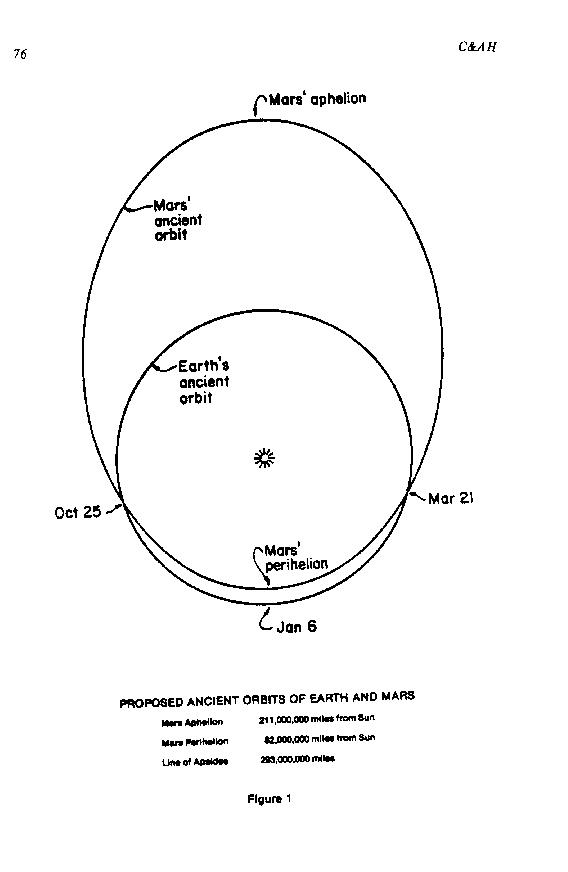
Thus we see divided opinion on the origin of the asteroids, of which about 2750 have been discovered and named. Opinions seem to reflect various astronomers' conceptions of the solar system's origin. And opinions are divided as to whether they gathered or accreted as might dew on ice, or whether they were the results of a "collision.' If they are the debris left from a collision, what planetary body could possibly have caused such an event?
Instilled into the psyche of most astronomers is the notion that Mars has been in its present orbit, like Jupiter, for billions of years and the asteroids do seem to be relatively young. In this essay we shall first discard the astronomer's notion that Mars has been in its current orbit for billions of years.Figure 1
In such an orbit Mars would go out into the area near the perihelion of most of the asteroids. The majority of the ten largest asteroids have perihelions that average 240,000,000 miles from the Sun.
One major concept of this paper is that Mars caused the fragmentation of a former small planet into the current asteroids. It was the gravitational force not of Jupiter (as Moore and Hunt suggest) but rather of Mars which caused Astra to disintegrate into asteroids.
A secondary concept implicit in this work is that Mars' former orbit was considerably more eccentric than its current orbit. And our ability to conceive this goes along with our rejection of the idea of planets or planetesimals accreting over billions of years as a viable theory for the genesis of any planet. Perhaps another catastrophic cosmology for the origin of the planets is needed.
A third concept is also implicit in this paper: Mars in its former orbit had the potential to interact catastrophically with the Earth-Moon system, since its perihelion was within Earth's orbit. The first concept, the presentation of evidence that Mars caused the fragmentation of a minor planet, will be discussed below; the second and third concepts, implicit and important though they may be, will not be developed in this paper.
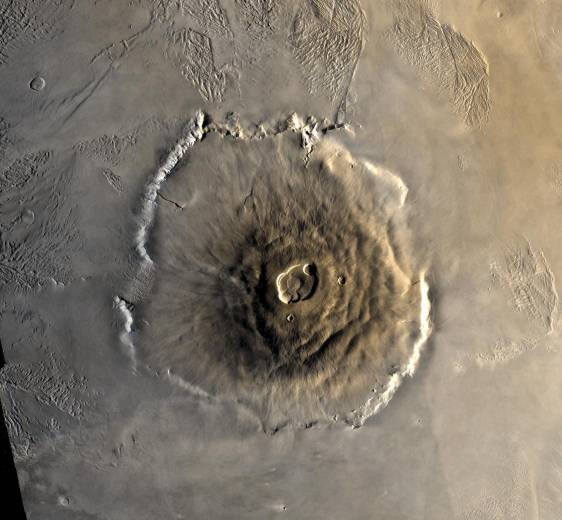
Olympus Mons
Thirteen levels of support shall be cited to demonstrate this new-and perhaps radical idea. It is new, because no others have yet hypothesized or described a Mars-Astra catastrophe, and it is radical, because traditional cosmologies suppose millions-if not billions of years necessary for such a catastrophe to have occurred.
The interdisciplinary levels of support are as follows:
1. Astrophysics-tidal distortion and Roche's Limit for fragmentation.
2. Commensurability�comparison of the sizes of Mars' craters and asteroids.
3. Commensurability-comparison of the numbers of Mars' craters and asteroids.
4. Geography-the Hemisphere of Craters on the surface of Mars.
5. Geography-the scattershot pattern of craters on Mars.
6. Geography the rimming of larger craters by smaller craters.
7. Geography the masked radial pattern of craters from the subpoint.
8. Physical geography-the evidence of bulging in the opposite hemisphere.
9. Physical geography-the region of vulcanism in the opposite hemisphere.
10. Physical geography-rifting: indication of an increased mass for Mars.
11. Astrophysics capture probabilities for the two satellites of Mars.
12. Astrophysics modeling and the retrograde motion of Deimos and Phobos.
13. Astrophysics five forces involved in the variety of asteroid orbits.
If it can be demonstrated that Mars was the sole cause for Astra's fragmentation, then we can say, as a demand deduction, that Mars was in a former orbit with higher eccentricity and a more remote aphelion. Assuming this, and to accommodate the principle of conservation of energy and angular momentum, a second demand deduction is that the former perihelion of Mars was nearer to the Sun than the present perihelion. Figure I models our understanding of Mars' ancient orbit.
1. Tidal Distortion and Roche's Limit
Planets and the larger satellites are not rigid bodies. They have crusts and fluid magma interiors, and they respond to gravitational forces according to certain formulas. In 1850 Edouard Roche recognized the nature of tidal stress versus the cohesive forces of a planet. He found that, for planets (and for larger satellites which are non-rigid), if they were on a collision course the tidal forces suddenly coming into play would exceed the cohesive forces before impacting. Fragmentation of the smaller body would precede impact.
Further, Roche stated that the critical distance of fragmentation is 2.44 radii from the center of the larger body. He assumed both bodies to have identical densities and circular orbits. In fact, circular orbits do not exist in nature, and densities of planets do vary; none are identical.
Sir George Darwin later refined Roche's study, offering 2.4554 as the critical distance of fragmentation. More recently, Loren Steinhauer researched this issue and came to the conclusion that a distance of 2.45 is conservative, and that a figure of 2.5 to 2.6 radii is more likely.[4]
Although we do not have data on the densities of the asteroids, it is likely that Mars has a greater density. The densities of certain planets and satellites in our solar system are as follows:
a. Earth
5.52
(1 = water)
b. Mercury
5.43
c. Venus
5.24
d. Triton
5.0
(Satellite of Neptune)
e. Pluto
4.7
f. Mars
3.93
g. Io
3.53
(Satellite of Jupiter)
h. Europa
3.03
(Satellite of Jupiter)
i. Titan
1.88
(Satellite of Saturn)
j. Ganymede
1.43
(Satellite of Jupiter)
k. Iapetus
1.16
(Satellite of Saturn)
Mars today has an equatorial diameter of 4222 miles and a radius of 2111 miles. For reasons presented later it is proposed that before the disintegration of Astra into asteroids Mars had a slightly smaller diameter, approximately 4198 miles, and a radius of about 2099 miles.
It is proposed (also for reasons to be developed later) that Astra had a diameter of no less than 1250 miles and a radius of no less than 625 miles. Figure I gives the geometry of these two planets in a fatal fly-by at the moment of fragmentation. We use a figure of 2.76 for Roche's Limit, which assumes Astra's density to be in the range of 3.0, significantly loss than Mars' density.
We postulate that Astra's diameter was 1250 miles, or slightly larger. This compares to the diameters of other solar system bodies as follows:
1. Moon (Earth) 2160 miles
2.Io (Jupiter) 2257
3. Europa (Jupiter) 1942
4. Pluto 1500
5. Rhea (Saturn) 950
6. Iapetus (Saturn) 895
7. Titania (Uranus) 800
8. Oberon (Uranus) 715
9. Charon (Pluto) 500
Thus it is proposed that Astra was very much like the
planet Pluto in size, but it was more like Jupiter's Europa in density
(about 3.0).
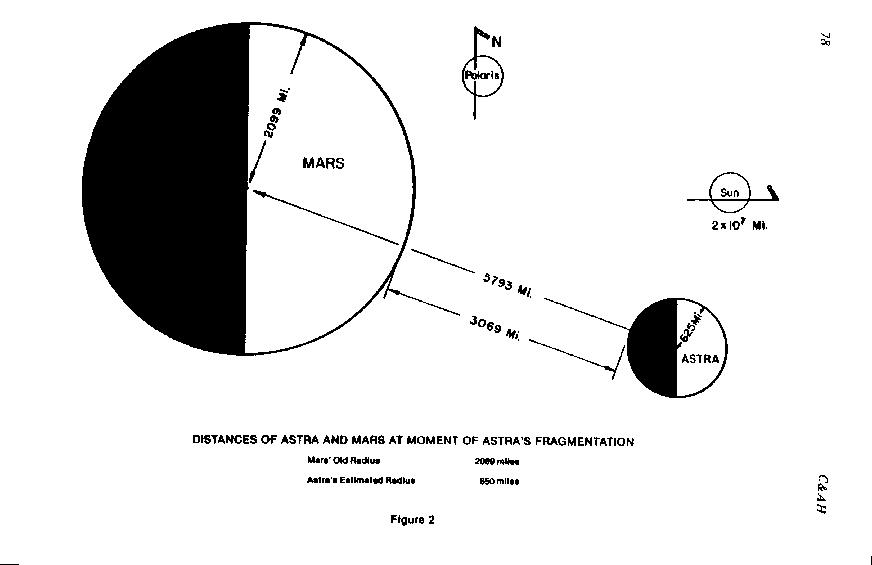
II. Size Comparisons of Martian Craters and Asteroids
A study of the sizes of
the larger Martian craters has been made. It assumes, perhaps too conservatively,
that the size of an impact asteroid hitting Mars was 90 percent of the
size of the crater in diameter. It is possible that percentages of 80 and
85 can be defended, and, if so, such would adjust the details of this paper
accordingly.
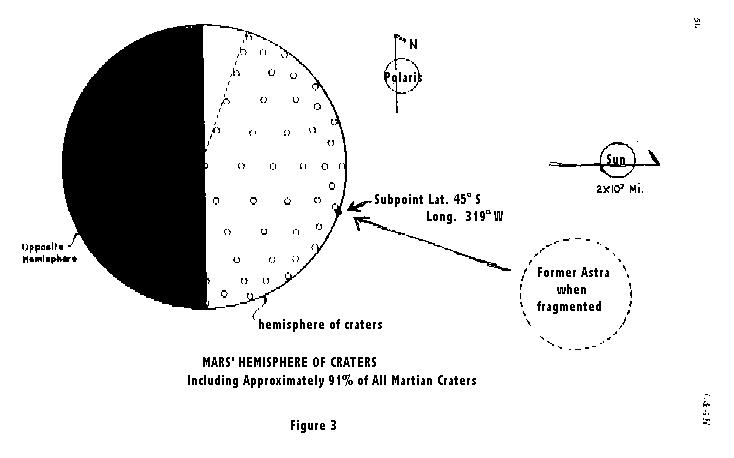
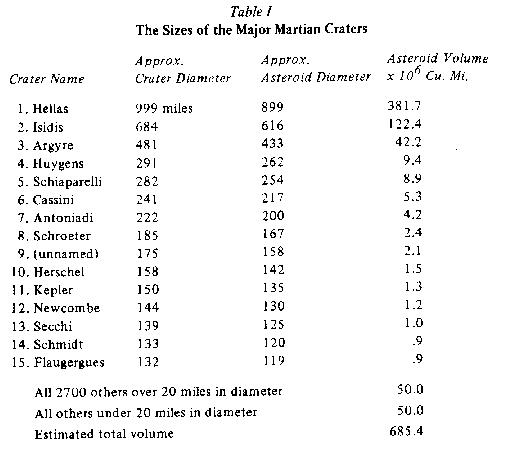

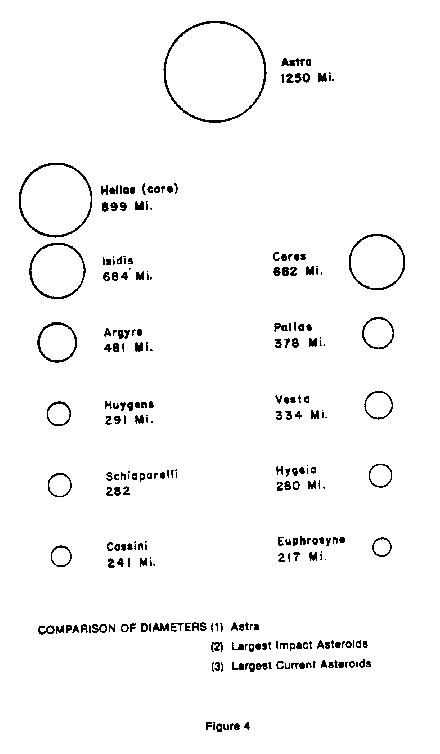
A commensurability occurs in the known sizes of
the 15 largest asteroids compared to the sizes of the 15 largest impact
asteroids hitting Mars; see Table II The sizes of the current asteroids
and the impact asteroids are estimated as follows for commensurability:
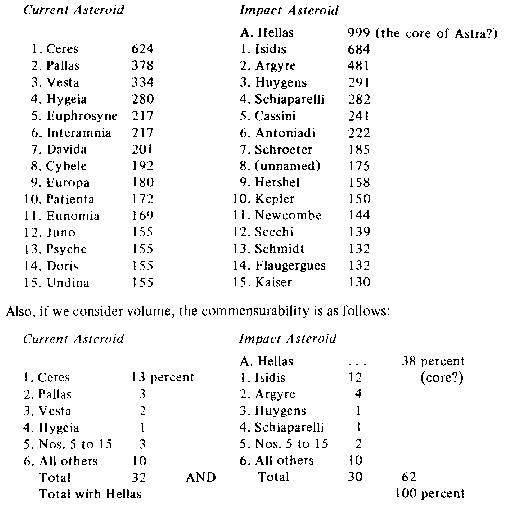
It would thus seem that, of the components of Astra. in number about one-half became impact asteroids, hitting Mars. As asteroids one-half missed Mars and proceeded to assume a variety of other orbits. But in volume about one-third of the mass of Astra was in the core, Hellas, and another third was in impact asteroids, and yet another third was in Mars-missing asteroids which we see today as current asteroids
On these calculations it is concluded that Astra had a diameter of somewhere between 1250 and 1300 miles, quite like Pluto with an estimated diameter of 1500 miles. Astra was significantly smaller than the Moon. And its distance was in the range of 205,000,000 miles from the Sun at the moment of its fatal fly-by with Mars.
Figure 4 illustrates a concept of the location of the fragments as Astra broke apart. Hellas was the core. Argyre was ahead of the core and impacted Mars 2 or 3 minutes earlier and to the west of the center of the impact area. Huygens was to the north and west of the core; Isidis was to the north and east, and very nearly missed Mars, just hitting on the rim of the Hemisphere of Craters. Pallas, Vesta, and Ceres missed Mars, whether to the north or to the south. (Figure 4 suggests a southerly direction, but this is subject to dispute.) Phobos and Deimos probably were ejected rearward as Astra approached Mars, gaining a motion opposite to Astra's approach trajectory, allowing their capture by Mars.
It may be properly questioned whether, among the 15 largest Martian craters, any of them are in the opposite hemisphere; not so-THEY ARE ALL IN THE SAME HEMISPHERE.
It may also be asked why we have
suggested an ancient diameter of 4198 miles for Mars rather than the current
4222. The answer is that during this catastrophic event, with Hellas, Isidis,
Argyre, and over 2700 other fragments which impacted Mars, arriving at
velocities in the range of 100 miles per minute over a span of some 25
minutes, the mass of Mars increased perhaps 1 1/2% percent. Such
an event calls for an expansion of the equatorial bulge, as shall be discussed
shortly .
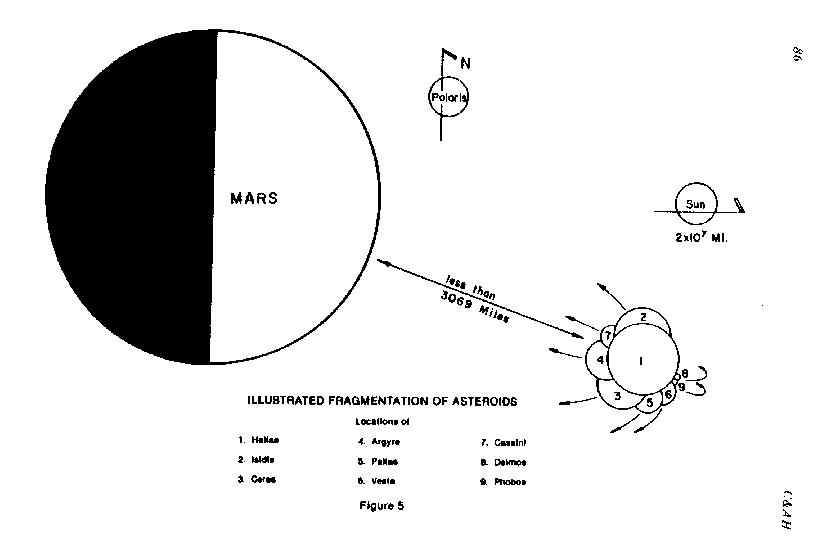
III. The Distribution of the Craters on Mars
On the heavily cratered planet Mercury the craters are somewhat equally distributed in both hemispheres, which is also true for the Moon. interestingly, the craters on Mars are not widely or evenly distributed in both hemispheres. Figure 6 illustrates the fact that 93 percent of all the craters 20 miles in diameter or larger are in one hemisphere. The "Hemisphere of Craters" is centered at Latitude 45 degrees South and at Longitude 319 degrees West. This hemisphere is termed "The Hemisphere of Craters" and its opposite hemisphere is called "The Opposite Hemisphere."
A count has been made of the craters 20 miles and larger in diameter on Mars. Table III collects these data.
The following conclusions can be made:
I . Mars received about 86 percent of its craters in one catastrophic day.
2. Mars received the other 14 percent of its craters during all other time.
3. The 14 percent in all other time impacted Mars equally in both hemispheres.
4. Approximately 2831 of the 3068 craters in the Hemisphere of Craters impacted Mars during one single day, and, for that matter, during one single 60-minute spasm of tidal upheaval and crater formation.
5. Apart from this catastrophic day, Mars has had an astronomical history far more serene, for whatever reason, than either Mercury or the Moon.
6, As expected, the highest crater count is in the 270 to 360 degree region.
7. The Hemisphere ot Craters is centered on the aforementioned subpoint of 45 degrees South Latitude and 319 degrees West Longitude.
8 The subpoint is just east of the massive Hellas Crater, which is logical if Hellas was the core of the fragmenting Astra.
It is to be noted that all 15 of the largest craters of Mars are in the Hemisphere of Craters. It is also noteworthy that the massive lava outflows of Argyre, Hellas, and Isidis undoubtedly have spread and occluded a certain significant number of craters Thus our figure of 3068 craters 20 miles and larger in diameter has been masked by these lava outflows; the original figure was even larger before lava flow and before larger craters occluded some smaller ones.
If there is a shift from our Table III, therefore, it will probably be in the direction of an even greater extreme. And the 7 percent crater count in the Opposite Hemisphere may in fact be somewhat larger than the original impact situation.

Valles Marineris
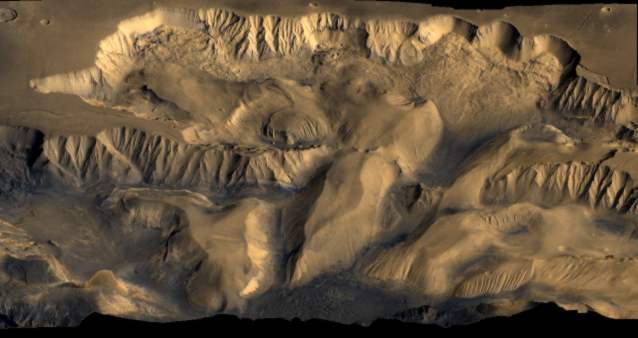
IV Other Geographical Patterns of the Martian Craters
1. The first and primary pattern to be observed is the aforementioned Hemisphere of Craters versus the Opposite Hemisphere, a dramatically different type of scenery.[5]
2. Scattershot pattern: in the Hemisphere of Craters the general pattern is a scattershot pattern, which is to say the distribution is "patternless" or random. And this is the second primary pattern.
3. The rimming of larger craters by smaller craters: if one examines the map of Mars, grid section by grid section, it may be noticed (perhaps only upon second or third examination) that an exceptional density of small-2 to 10 mile diameter craters exists on the rims of a surprising number of larger craters. Kaiser has about a dozen. Secchi with seven rim craters is another example, as is Cassini with five. What might this mean?
Crater rimming might mean one of two things. First, and more probably, even during the 30-minute timespan between fragmentation and impact into Mars the larger asteroid fragments were attracting groups of smaller fragments as momentary satellites. Second, and less probably, the smaller fragments might have experienced a ricochet effect, bouncing off the larger ones but remaining near at hand.
4. A masked radial pattern: Again,
if one examines the map of Mars, grid by grid, and establishes a frame
of reference, and if one recognizes the location of 45 degrees South and
319 degrees West as the subpoint under Astra, the centerpoint of the Hemisphere
of Craters, then one may detect a masked distribution of craters in an
arc or arcuate pattern with the arc center being the subpoint. Craters
on the rim of the Hemisphere of Craters are an excellent example. Other
examples occur in the Denning to Kaiser sequence, 325 to 340 degrees West
Longitude and 18 to 47 degrees South Latitude. Another series is Proctor
at 330 degrees West and 48 degrees South and the arcuate series to the
north .

Impact Crater "Kaiser", notice "wind made" sand
dunes
At a distance of 205,000,000 miles from the Sun a planet such as Astra, or a contemporaneous asteroid, will be revolving at a rate of about 6000 miles per hour in orbit relative to the Sun. The motion of Mars is a second factor to be considered, but for general purposes it is assumed that the Astra fragments approached Mars at a rate of 6000 miles per hour. With reference to Figure 2, the impacting of asteroids began about 31 minutes from the moment of fragmentation, and it was all over in about 25 minutes, except for certain other aftermath effects which will be discussed shortly. Thus the time for torture of Mars' crust was only 55 to 60 minutes in duration. Initial pressure and shock waves within Mars may have lasted another 15 to 30 minutes
When did this catastrophe occur? Traditionally astronomical essays reflect the nebular hypothesis principle of a genesis four to five billion years ago of the solar system, from which point discussion usually begins. In the present essay we do not know when fragmentation occurred.These indications will be reserved for a future essay. Nevertheless, whatever the lapsed time, a study of drifting dust into (and out of) Mars' craters, especially the rates of dust drifting, along with its quantities, should give an approximation of the timing of the Astra-Mars event.
One thing is clear-that there has been a subsequent watery catastrophe for Mars, with ancient rivers forming channels at a much more rapid flow rate than rain-fed rivers on Earth. That watery event appears furthermore to have been later in time, since the channels appear to be superimposed on Mars' cratered physical geography.
Two additional suspicions need also to be stated. One is that at the time of Astra's fragmentation Mars had an icy satellite somewhat like the satellites of Uranus in size, 500 to 800 miles in diameter, and composed of ice like some of the satellites of Jupiter. This "frosty" body we suggest, was also impacted to some extent by Astra fragments and we postulate that Astra had a high proportion of iridium which was deposited both on the crust of Mars and its ancient icy satellite. Thus the subsequent fragmenting or the "frosty" satellite may have had something to do with Mars' channels and may also account for the high iridium concentration in the sub-sea level deep ice deposits on Mars' antarctic bedrock. This is to suggest there was a subsequent and very severe Earth-Moon interaction with the Mars-Frosty system, as depicted in Figure 1.
REFERENCES
1. Otto Struve and Velta Zebergs, Astronomy of the 20th Century. New York: Macmillan 1962 179.
2. James S. Pickering 1001 Questions Answered about Astronomy. New York: Dodd, Mead, 1958, 73.
3. Patrick Moore and Gerry Hunt, Atlas of the Solar System. Chicago: Rand McNally, 1983, 245,
4, Loren C. Steinauer, "Out of Whose Womb Came the Ice?" - Symposium on Creation IV, Grand Rapids: Baker Book House, 1972, 134ff
5. Don E. Wilhelms "The Martian Hemispheric Dichotomy may be due to a Giant Impact." Nature, Vol. 309 (May 10, 1984), 138.
Mars is divided into two fundamentally different geological provinces of approximately hemispheric dimensions. The more southerly province is heavily cratered, contains relatively old geological features, and superficially resembles the lunar and mercurian highlands. The northern province is relatively lightly cratered and contains younger geological units, including extensive plains, volcanic edifices, and volcanic calderas.
"The Scars of Mars" will also appear in two installments in Kronos, July 1985 (Vol. 10 No. 3), and November 1985 (Vol. 11 No. 1).
DONALD W. PATTEN, born in Montana, is a veteran of the
Korean War. He received both B.A and M.A. degrees in Geography from the
University of Washington. He is the author of The Biblical Flood and the
Ice Epoch (l977) and The Long Day of Joshua and Six Other Catastrophes
(1973), as well as editor of the "Symposium on Creation"series. He lives
in Seattle, Washington.
ALTERNATIVE THREE in RealVideo
Articles from Catastrophism
And Ancient History
are brought to you by The Thule Foundation